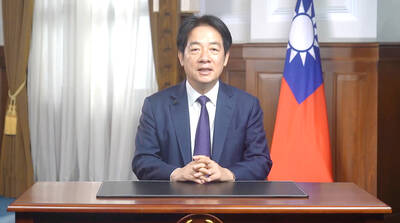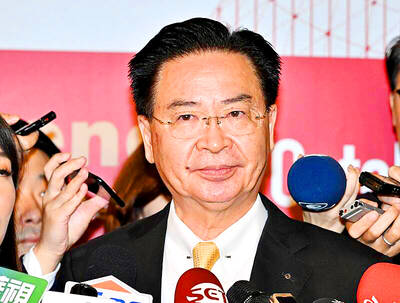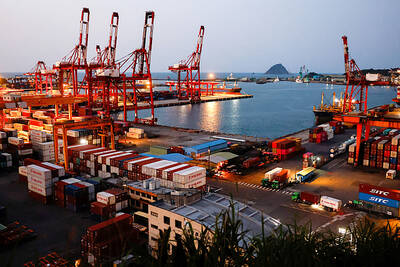Flooding triggered by torrential rains killed at least 44 people and forced the evacuation of about 330,000 in a mountainous region of southern China, the government said yesterday.
The flooding in the Guangxi region also left another 23 people missing and wrecked more than 20,000 houses, the official Xinhua News Agency said, citing disaster officials.
The area has been pounded by heavy rain since Saturday, causing swollen rivers to overflow their banks, Xinhua said.
Some 333,000 people have been evacuated from flood-prone areas to higher ground, the agency said.
The Wuzhou River was 8.5m above its danger level at midday yesterday, Xinhua said.
As the waters rose, the city of Wuzhou evacuated 20,000 of its residents, China Central Television (CCTV) reported, as it showed images of police helping elderly residents.
Along the river, thousands were working to fortify its banks and dams by piling up bags filled with earth, CCTV said.
Notices on the mass evacuation were posted on walls in the area, warning sirens blared in the dark of night and Wuzhou residents began to load up cars, trucks and carts with valuables and flee the area for higher ground.
"In the face of these floods, the attitude of the government is to make sure that no one is killed," Ren Kuikang, chief of the Wuzhou flood control and drought relief office, told state television.
With much of southern China now under threat, Premier Wen Jiabao (
Earlier this month, a flash flood swept through a low-lying primary school in Heilongjiang Province, killing 117 people, 105 of them children.
Flooding in Guangxi had killed 24 people and left 23 missing, Xinhua news agency said, citing provincial flood control officials.
More than 330,000 people had been evacuated to higher ground in the region, where the flooding has caused 1.67 billion yuan (US$201 million) in economic losses, damaged 328,000 hectares of crops and toppled more than 20,000 houses, it said.
Flooding damaged another 50,000 houses regionwide.
Authorities had expected the Xijiang, which has risen at a rate of 10cm per hour, to peak on yesterday night at a hydrographic station in Wuzhou.
Heavy rains have killed nine people since Saturday in Guangdong, where a landslide disrupted traffic on a rail line linking China with Hong Kong, Xinhua said.
Rainstorms in Guangdong caused cave-ins on part of the Beijing-Kowloon railway line, forcing dozens of trains to either delay or turn back while repairs were made, it said.
Water levels on two other rivers in Guangxi -- the Qianjiang and Xunjiang -- were above warning levels and the province had suffered nearly US$45 million in economic losses as of Monday due to the recent deluges, Xinhua said, citing local flood control headquarters.
In Fujian Province, floods and landslides had killed 12 and left five missing, it said. In Shunchang County alone in northern Fujian, dozens of landslides had buried nine people, killing five. Three were missing.

ACTION PLAN: Taiwan would expand procurement from the US and encourage more companies to invest in the US to deepen bilateral cooperation, Lai said The government would not impose reciprocal tariffs in retaliation against US levies, President William Lai (賴清德) said yesterday, as he announced five strategies to address the issue, including pledging to increase Taiwanese companies’ investments in the US. Lai has in the past few days met with administrative and national security officials, as well as representatives from various industries, to explore countermeasures after US President Donald Trump on Wednesday last week announced a 32 percent duty on Taiwanese imports. In a video released yesterday evening, Lai said that Taiwan would not retaliate against the US with higher tariffs and Taiwanese companies’ commitments to

‘SPECIAL CHANNEL’: Taipei’s most important tasks are to stabilize industries affected by Trump’s trade tariffs and keep negotiations with Washington open, a source said National Security Council Secretary-General Joseph Wu (吳釗燮) arrived in the US for talks with US President Donald Trump’s administration, a source familiar with the matter said on Friday. Wu was leading a delegation for a meeting known as the “special channel,” the Financial Times reported earlier. It marked Trump’s first use of the channel since returning to the White House on Jan. 20. Citing a source familiar with the matter, the Financial Times reported that Minister of Foreign Affairs Lin Chia-lung (林佳龍) was also a part of the delegation. The visit came days after China concluded war games around Taiwan and amid Trump’s

CHIP EXCEPTION: An official said that an exception for Taiwanese semiconductors would have a limited effect, as most are packaged in third nations before being sold The Executive Yuan yesterday decried US President Donald Trump’s 32 percent tariff on Taiwanese goods announced hours earlier as “unfair,” saying it would lodge a representation with Washington. The Cabinet in a statement described the pledged US tariffs, expected to take effect on Wednesday next week, as “deeply unreasonable” and “highly regrettable.” Cabinet spokeswoman Michelle Lee (李慧芝) said that the government would “lodge a solemn representation” with the US Trade Representative and continue negotiating with Washington to “ensure the interests of our nation and industries.” Trump at a news conference in Washington on Wednesday announced a 10 percent baseline tariff on most goods

Intelligence agents have recorded 510,000 instances of “controversial information” being spread online by the Chinese Communist Party (CCP) so far this year, the National Security Bureau (NSB) said in a report yesterday, as it warned of artificial intelligence (AI) being employed to generate destabilizing misinformation. The bureau submitted a written report to the Legislative Yuan in preparation for National Security Bureau Director-General Tsai Ming-yen’s (蔡明彥) appearance before the Foreign Affairs and National Defense Committee today. The CCP has been using cognitive warfare to divide Taiwanese society by commenting on controversial issues such as Taiwan Semiconductor Manufacturing Co’s (TSMC, 台積電) investments in the